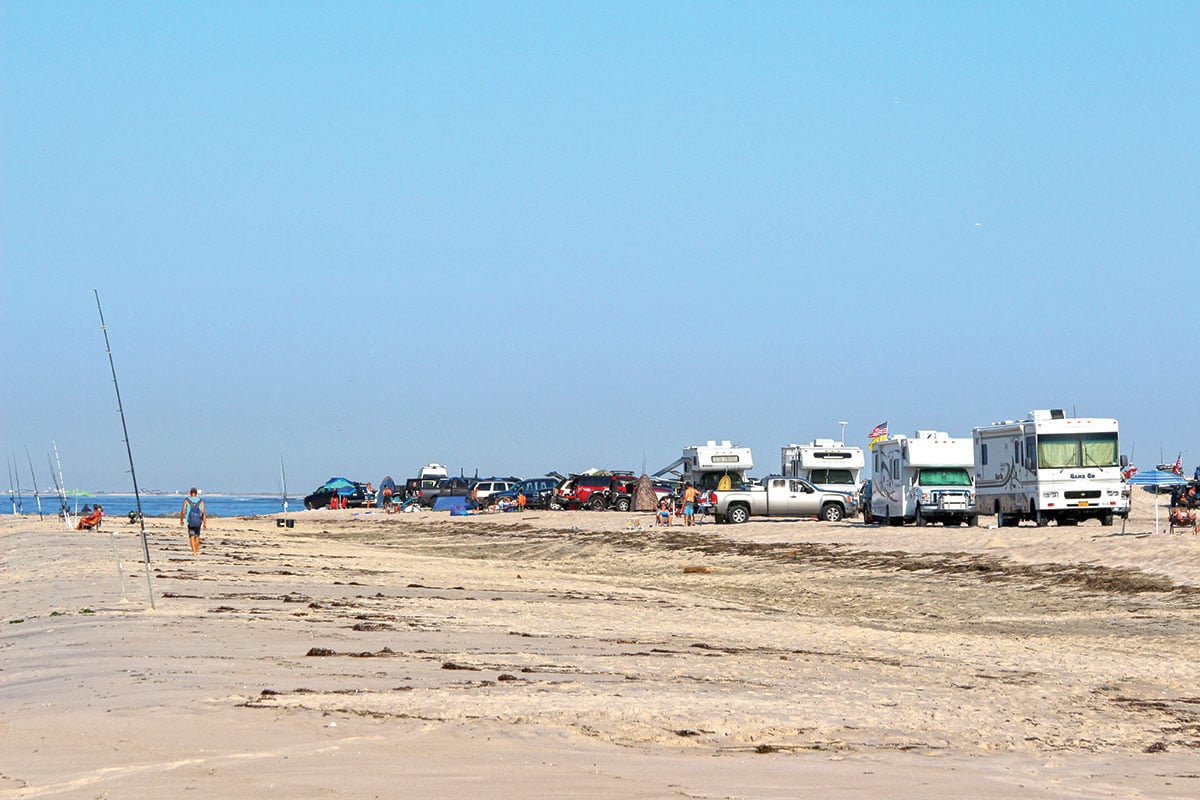 Everything you need to know to make driving on the beach a hassle-free way to reach those off-road hotspots.
Everything you need to know to make driving on the beach a hassle-free way to reach those off-road hotspots.
Surf fishing is an exceptionally rewarding experience. But finding feeding fish along an open expanse of beach can mean covering lots of ground. Luckily, you can drive on a number of beaches, with the right gear and proper permits. It also takes some know-how to make sure your rig doesn’t become the next piece of structure to grace the sand. Here’s a primer on staying unstuck—and staying in the good graces of your fellow anglers. Most states regulate beach access with a permit system, so be certain to check with whatever agency is in charge of the beaches you plan on frequenting for their requirements. They could be regulated by federal (National Seashore), state, county or town governments.
Most issuing authorities also require that you keep certain gear in your vehicle to be somewhat self-sufficient when you’re out driving where the ocean meets the land. Not only is this equipment required, it really will save the day when you run into an issue on the soft stuff. Below is a list of items that I keep in my truck whether I’m driving on the beach or chasing blue lines on logging roads beyond the bounds of cell phone coverage.
Tools: Tows off the sand are expensive. Save yourself some money by keeping enough tools onboard to get you back to the blacktop.
Jack and Jack Board: A jack will sink into the sand; a 2-foot square of 3/4-inch plywood will keep the jack on top.
Water: Driving slowly on the sand is taxing, and the lack of airflow can lead to overheating. Keep a few gallons of water (potable, so you can drink it in a pinch) on board in case of overheating.
Fire Extinguisher: Hopefully you never need it, but vehicle fires do happen.
Recovery Gear: Tow straps, chains, shackles, and other means to get your rig going again if you do succumb to the sand. Recovery points front and rear make it easy on whoever helps you out of the jam.
Emergency Gear: I always have enough supplies to get me through a few nights should the unthinkable happen. This includes tarps, blankets, extra clothes, a fire making kit, and plenty of nonperishable food.
Full-Size Shovel: Forget about an E-tool; a full-size shovel is much easier on your back if you need to dig your rig out.
Traction Aid: Some sort of traction aid is well worth its weight when it comes time to get you out of trouble. A sand ladder can be a lifesaver when the beach suddenly goes soft on you.
Compressor: If you’re going to air down, you need a way to air back up. Spend the money and get a reliable unit that won’t leave you stranded when you need it most, especially if there are no air stations nearby.
Full-Size Spare: The beach is no place for a donut. A smaller tire will only get you stuck, and possibly damage your four-wheel-drive system in the process.
Tire Repair Kit: If you have a compressor in your truck, it is often easier to plug a tire than it is to change it. Practice on some old tires before you go off-road. Spare valve cores are useful because you will lose some if you loosen them to deflate your tires.
Toilet Bucket: Having the ability to use the bathroom on the beach keeps it clean for others. Don’t be that guy.

Traction Systems
Years ago, there was only one type of four-wheel-drive system. You shifted the transmission into neutral and yarded on a lever until it lined up with the “4-Hi” logo. Once that was accomplished, you hopped out of the cab and turned the hubs on your front wheels to the “4WD” position and went on your merry way. Now, the lever has been replaced with a push-button in most vehicles, and locking hubs are absent on everything but the heaviest of trucks. Increasingly, electronics have displaced mechanical apparatus to provide power to all four corners.
In vintage four-wheel-drive systems, and some modern trucks and sport utility vehicles, shifting into 4WD engaged the front axle shaft, which provides motivation for the front wheels. If you nudged the lever a little further into “4-Lo,” you would lock the transfer case, forcing it to provide no more than 50 percent of power to the rear and 50 percent of power to the front wheels.
All-wheel drive systems have become more common than true 4WD systems today. In some cases these are touted as four-wheel-drive systems by their manufacturers, but lack the locking center differential, also known as a transfer case, that is the hallmark of a true four-wheel-drive system. This configuration uses an open center differential, sending power to both the front and rear in an “as needed” fashion. To provide the appearance of four-wheel-drive, a computer monitors wheel spin using the sensors in the anti-lock brake system and provides braking force when a discrepancy in wheel speed is detected, retarding the faster spinning wheels and directing power to the wheels with better traction.
Such systems outperform true 4WD systems on the road, with better gas mileage and turning radii, but take a back seat to the mechanical systems when it comes to off highway performance. But, as with most technological advances, things are getting better all the time. Some vehicles even have a dedicated sand mode, capable of diverting power in tenths of a second intervals, allowing the vehicle to crawl out of some very sticky situations.
If you have a vehicle that has traditional a 4WD system, switch it into 4-Hi to hit the sand. Use whatever setting most closely approximates that if you don’t, but you may have to experiment to find what works best for your rig.
Tire Selection
 Having the right tires goes a long way towards preventing you from getting stuck on the beach. It may seem counterintuitive, but tires with aggressive “off road” tread patterns actually perform fairly poorly in the sand. These designs were typically created with mud and rocks in mind, with wide voids and deep valleys between lugs. These are great for gripping smooth rock surfaces and slinging mud, but they tend to bury themselves in a hurry in the sand.
Having the right tires goes a long way towards preventing you from getting stuck on the beach. It may seem counterintuitive, but tires with aggressive “off road” tread patterns actually perform fairly poorly in the sand. These designs were typically created with mud and rocks in mind, with wide voids and deep valleys between lugs. These are great for gripping smooth rock surfaces and slinging mud, but they tend to bury themselves in a hurry in the sand.
Probably the best design for soft sand is the smooth tires found on farm implements, but those would perform poorly on the road, skidding every time they came in contact with any sort of water. These types of tires are prohibited for on-road use by the Department of Transportation anyway, so you only find them on purpose-built rigs blasting across the California dunes.
So the next time your rig needs new shoes, avoid the temptation to get a mud terrain tire. For general use in the Northeast, an all-terrain design rated for snow is hard to beat. You’ll have better performance on the beach, and will avoid the whine that is typical of those aggressive tread patterns while on the highway.
Airing Down
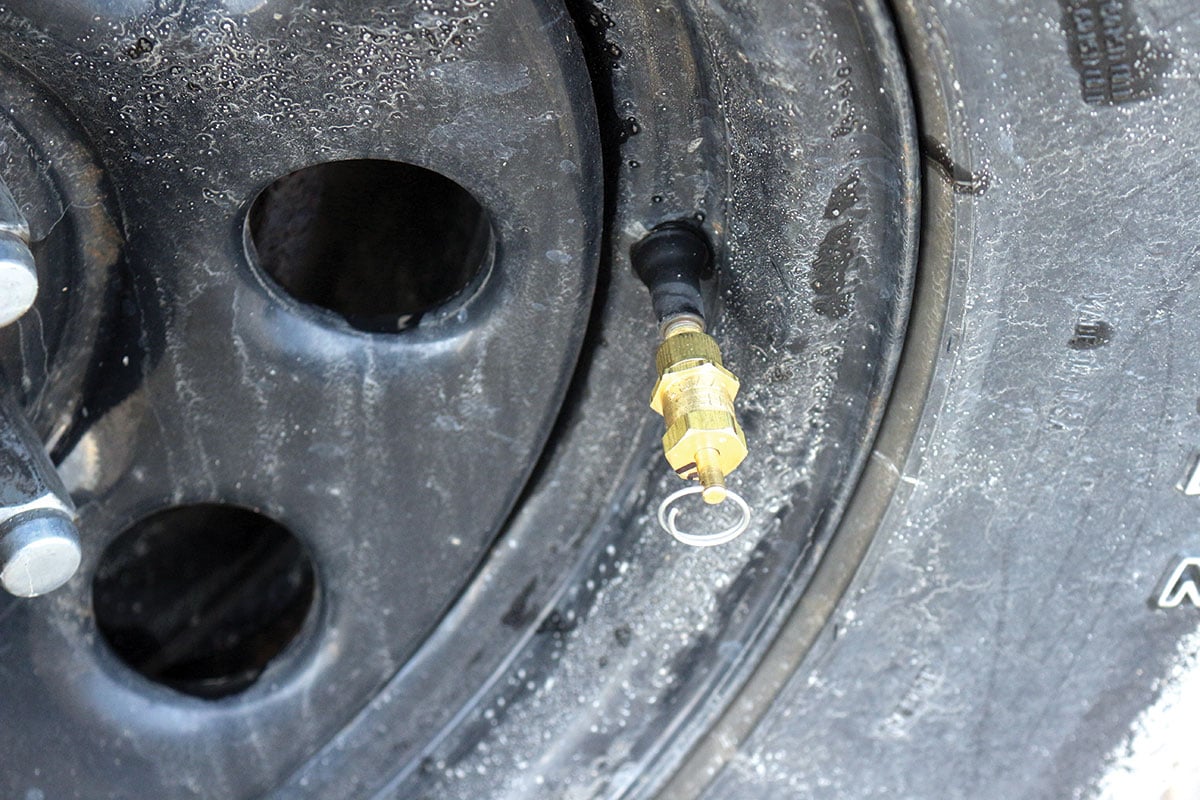
The first step in successfully floating over the sand is increasing your vehicle’s surface area. The only part of a motor vehicle that actually contacts the ground is its tires, giving birth to the old adage “where the rubber meets the road.” The more rubber that touches the road, the more grip the tires will provide, or in the case of loose or soft substrates such as sand, more floatation. Simply put, the wider the tire, the less likely you will be to get stuck in the sand.
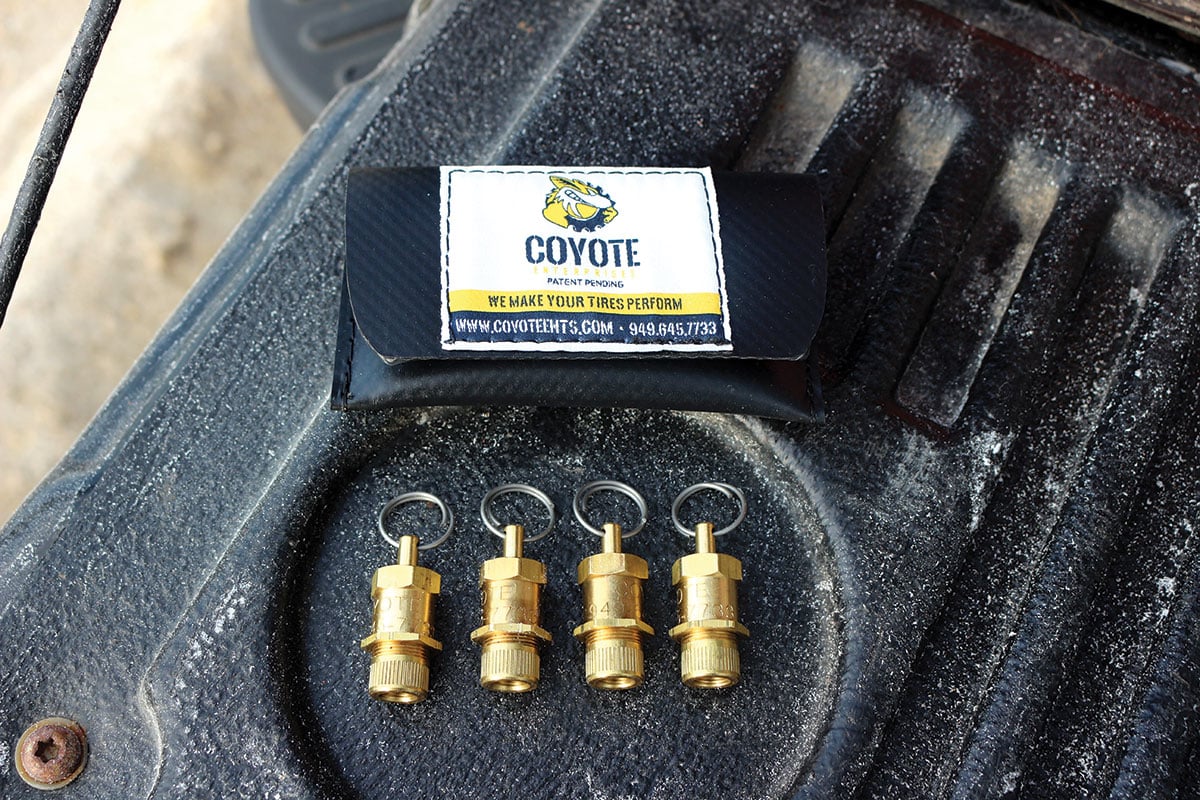
The manufacturers of most on-highway vehicles stipulate that the tires should be filled anywhere from 30 to 80 pounds per square inch, depending on tire type and gross vehicle weight. Maintaining this pressure minimizes rolling resistance, giving your vehicle the best possible gas mileage while minimizing tire wear. But lowering the pressure in your tires increases their surface area, giving you a wider contact patch that helps float over the sand.
Just how low you can drop your tire pressure is dependent on the weight of your vehicle. If you have a heavier vehicle, such as a full-sized pickup with a slide-in camper, you would be ill advised to drop your tires to the same pressure as a mid-sized SUV. When the pressure gets too low, you run the risk of “popping a bead,” with the tire coming loose on the rim. Reseating the tire requires a fair amount of air pressure – typically greater than most portable inflators are capable of – so this should be avoided.
Most vehicles can safely drop down to 15 pounds per square inch (PSI) which will keep you on top of even the softest sand. Significantly heavier vehicles, like the aforementioned pick up/camper combination, may not want to go below 20 PSI. I’ve had a full-size pickup down as low as 8 PSI without issue, but that was only to get out of a soft spot that had started to consume the truck’s tires.
There are a number of different ways to let air out of your tires. The most convenient are the purpose-built deflators that screw on to your tire’s valve stems and release air until a pre-selected pressure is reached. The Amazon knock offs seem to be hit or miss, so spend the coin on a good set from a reputable manufacturer such as Coyote. The Coyote deflators are built like a tank, and utilize a lock nut to keep them from loosening like their competitors. After trying a bunch over the last two decades, these are the best I’ve ever used.
Make sure you air back up before you hit the pavement. Failure to do so will result in a bumpy ride that will quickly wear your tires. At lower pressures, your vehicle will also perform poorly on-road. It will not be as responsive during turns and the nose will dive excessively under braking. Take the few minutes needed to fill your tires back to street pressure, even if you’re only traveling a short distance.
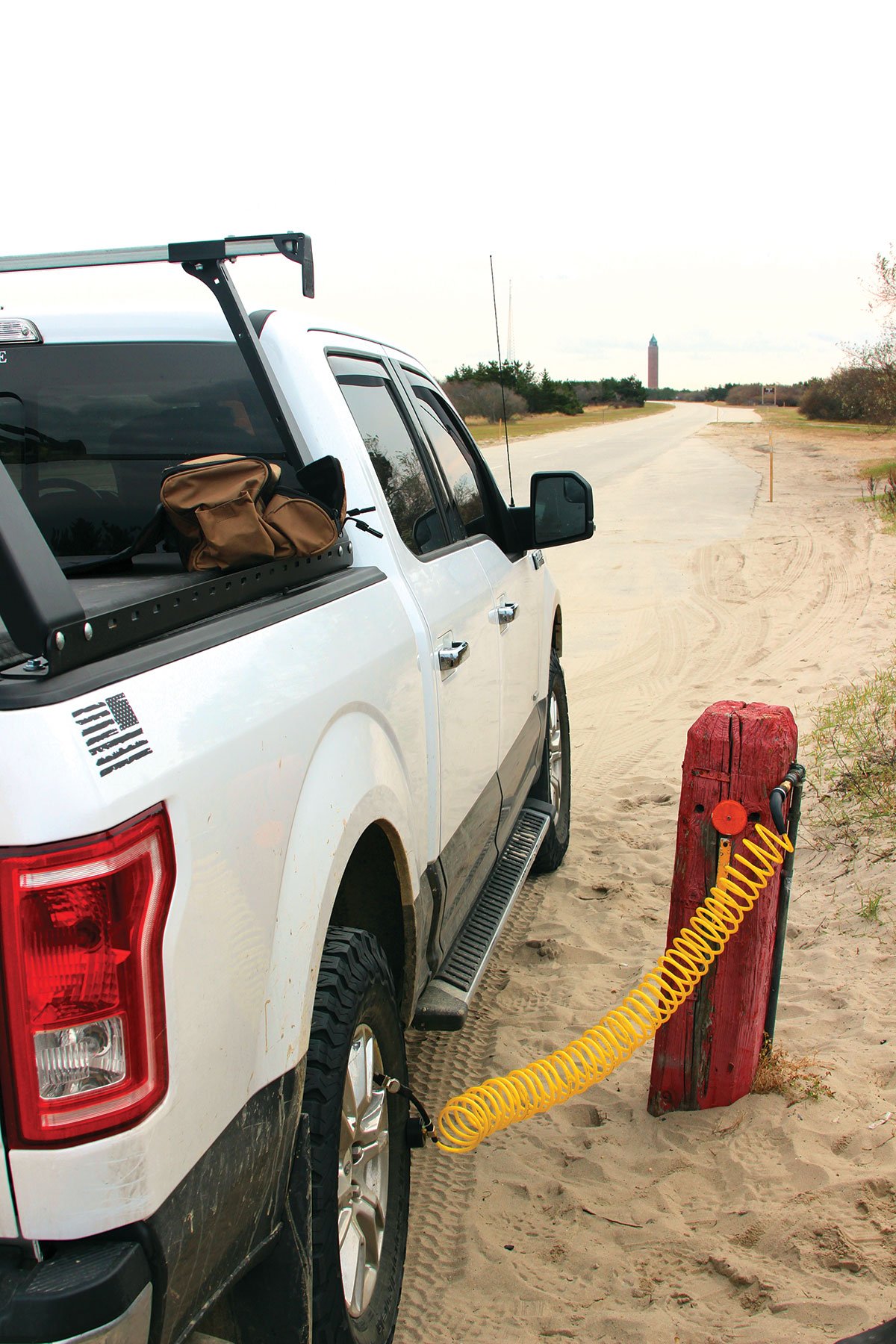
If You Pop A Bead

If your tire pressure does dip low enough, or you hit an obstacle hard enough to jar it loose, you may be able to perform a field-expedient fix utilizing a ratchet strap. As I mentioned earlier, reseating a bead requires quite a bit of air pressure, as well as volume. As you are limited by the output of your compressor, the work-around involves decreasing the volume inside the tire.
Take a ratchet strap—or two, the thicker the better—and wrap them around the tire in a manner similar to how you would install snow chains. Tighten the straps down as much as you can, forcing the tread inward toward the rim. Now your compressor has significantly less space to fill before it can start building pressure. Keep an eye on where the sidewall meets the rim, and note when it pops back into place.
Once it does, you can start loosening the strap, a little at a time. You don’t want to take it completely off until you surpass the pressure that you lost the bead in the first place. For good measure, increase the pressure in each tire by about 5 PSI before you begin forward momentum again.
Picking A Line
The golden rule of four-wheel-drive is to only use it to get out of trouble, not put yourself in. We’re throwing that right out the window, so we need to pay significant attention to where we place our tires. The permit offices of many area beaches are filled with pictures of trucks that were swallowed by the sea, so don’t take this endeavor lightly. The old cliché of “it only takes a second” definitely applies to beach travel, so heed these tips to help you pick the best line on the sand.
One of the best ways to ensure your fishing rig doesn’t become the next piece of near-shore structure is to always stay above the high tide line, but paying attention to a few key clues can save you from major headaches. When you’re airing down, examine the condition of the sand. If it has rained recently, the surface will likely be relatively hard packed, with the moisture pulling the sand tightly together. But if there’s been a prolonged dry spell the sand will be especially soft. If this is the case, consider airing down even more than normal.
Before you tap the skinny pedal, look for any potential obstacles, such as drift wood or deep holes left by less considerate beach drivers. Generally, staying in the existing ruts is the best course of action – if the previous vehicles made it through, you likely will too. Just look far enough ahead to spot any pitfalls that the last traveler encountered. If you see that the tracks stop abruptly, it’s probably in your best interest to pick another line.
Also be on the lookout for patches of soft sand that will bog your vehicle down and sabotage forward progress. Keeping your windows open as you drive can provide clues you might otherwise miss. If you hear your tires starting to spin faster than they previously were, immediately back off the throttle. Drop down to a lower gear, or put the transfer case into 4-Low if possible. If the RPMs start getting up there, your tires will bury you.
Turning can be an issue. If you try to pull a 180-degree turn, the sand will quickly swallow your rig as the diagonal tires are met with a lot more resistance than ones traveling straight. If you feel yourself starting to get stuck, straighten the wheels out until you regain forward momentum and try your turn again at a section of beach where the sand is more packed. Switching from one set of ruts to another can also be problematic, so be careful when doing so.
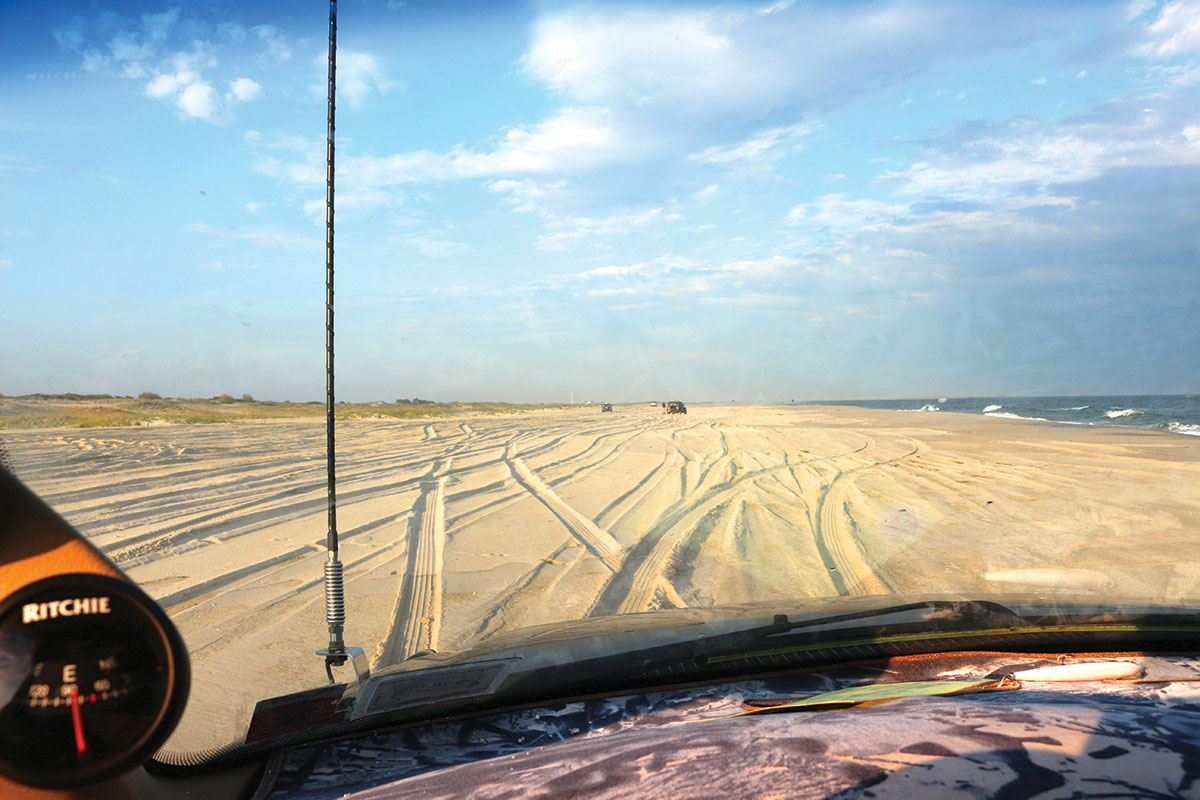
Speed Hurts
I was fortunate enough to attend college in one of New York State’s more rural counties. Just off campus was a vast network of seasonal and fire roads that permitted you to easily log 100 miles without touching pavement. It was on these thoroughfares that I learned how true the old axiom “speed hurts” is. I had come upon a vast straightaway, some two or three miles long, and buried the skinny pedal. While my old Jeep wasn’t traveling at Trophy Truck speeds, I was moving fast enough to cause a small rock to pancake my muffler and significantly alarm my passenger.
I wasn’t going fast, but it was fast enough to do some real damage. Lesson learned, and now I know to keep my speed down on unimproved surfaces because they will throw you a curveball, no matter how good the visibility appears to be. You probably won’t encounter any boulders, but you may come across debris deposited by high tides or inconsiderate beach goers. Hitting a piece of driftwood, or dropping into an unseen hole, at 15 miles per hour can knock a tire loose or cause considerable damage. When on the beach, limit your speed to the single digits and your truck will thank you for it. Most beaches have speed limits in place that can range anywhere from 5 to 20 mph.
Courtesy Counts
British economist William Forster Lloyd wrote an essay in 1833 detailing the decimation of a shared pasture by unregulated grazing, calling the resultant destruction of the grassland the tragedy of the commons. While there’s no danger of overgrazing on the beachfront, the beach bears the scars of our actions. It can be tempting to skip airing down on a well-traveled beach, but to do so only speeds erosion by deepening ruts and creating a bumpy ride for those following behind you.
Traveling on or over the dunes quickly destroys a fragile ecosystem. Ignoring signs for closed sections, such as nesting areas, is also harmful and can cause managers to shut down motorized access. Litter is another major concern, as anyone that has spent any time on the beach will tell you. If you brought it with you, take it with you when you leave. Even if you didn’t bring it there, take it with you.
In the dark of night, any errant light that hits the surf zone will send fish scrambling for the depths. When traversing the beach at night, leave the high beams off. Use just enough light to see the path ahead of you, and be cognizant of where your headlights are shining. If you’re making a turn that necessitates pointing your truck toward the surf zone, consider turning your headlights off for a moment if it is safe to do so. Likewise, consider your fellow angler’s night vision and don’t throw any light on them either.
Getting Unstuck
No matter how great a driver you are, you may get stuck at some point. One summer in my youth, I had a job monitoring nesting sea and shore birds at area beaches. A few times a week, I would also perform productivity checks on a least tern colony, a trek that required driving over more than a few miles of sand not compacted by regular truck traffic. All was well until the dry mid-summer sand swallowed the truck to the frame with no warning. I was doing everything properly, but physics just weren’t in my favor that day.
If you sense yourself starting to get stuck, immediately take your foot off the gas. The more your tires spin, the deeper they will dig themselves. Immediately exit the vehicle and perform a quick walk around to assess the situation. If you’re not buried too deep, let a little more air out of the tires, say 5 PSI or so, and gently rock the truck back and forth. Any time you hear the wheels spin, take your foot off the throttle.
If you hear of a vehicle catching fire on the beach, this operation is likely the culprit. The rocking action, coupled with the lack of cooling airflow, is enough to cause transmissions to overheat. In doing so, the fluid starts to boil, and will spill out of whatever vent it can. This fluid can then come in contact with the super-hot portions of the vehicle’s exhaust, and ignite. If you don’t get unstuck quickly, stop rocking and give the vehicle a minute to cool down while you examine other options.
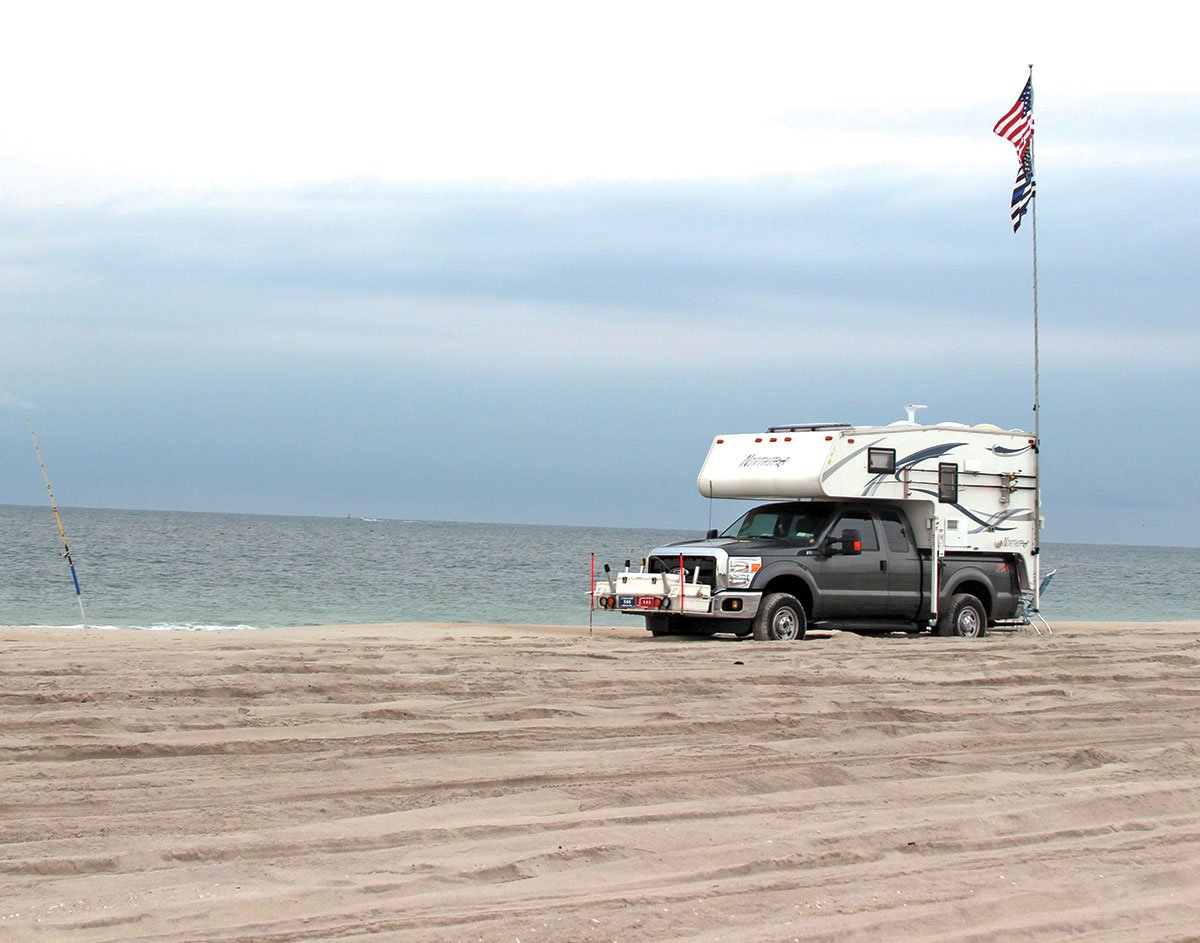
If you have some sort of traction aid in your vehicle, now is the time to retrieve it. The simplest of these are the floor mats right under your feet; sometimes placing these on the soft sand in front of or behind your tires can provide enough flotation to get you out of the hole you’re digging. Obviously using a part of your vehicle’s upholstery is less than ideal, so you should carry another solution. If you’ve ever watched the any of the truck races across the desert, then you’ve likely seen a set of sand ladders strapped to the side of a well-equipped Land Rover.
Sand ladders help by distributing your vehicle’s weight over a wider footprint and giving your tires something more substantial to grip. I carry a set that I cut from a piece of fiberglass-reinforced grate, like you might find functioning as a catwalk in an industrial building. They have held up to a few uses so far, including acting as a jack board. But there are many commercial versions on the market, made from a variety of materials ranging from aluminum to high-performance thermoplastics. Even a pair of 2 x 6 boards can help get you back on top of the sand.
Devices that you strap on over your tires can also go a long way toward providing forward momentum. Products like Trac-Grabbers install quickly and provide a lot of grip, acting like a paddle to propel you forward. If you’re not totally buried, these will usually have you back on your way in no time. One word of caution with these devices: They can dig you in as quickly as they can dig you out. Use the lowest gear possible, and go easy on the throttle. If you don’t get moving again quickly, then shut it down and look for another approach.
Jacking the truck up and filling in the holes created by the tires is an excellent way to get yourself out of a bind. This is often easier said than done, as you’ll need to clear away the sand by your vehicle’s jack points. You’ll also need some sort of hard surface, such as a 2-foot square of 3/4-inch plywood, to prevent the jack from burying itself under the weight of your four by four. Once you have the space needed, jack the truck up as high as needed to get the tires above the sand and fill in the ruts, compacting the loose fill with the back of the spade as you fill.
An easier way to lift your truck up is to use an exhaust jack. These devices are basically marshmallow-shaped bags that can use exhaust gases or your air compressor to inflate them and elevate your vehicle. When empty, exhaust jacks are but a couple of inches thick, so you probably won’t need to break out the shovel to get them in place. And because they have a large footprint, no jack board is required. Just slide them into place and fill as needed to get your truck high enough to fill your ruts and be on your way. There are a few different makes on the market, but the Bushranger X Jack by Australian off-road specialty company ARB is the best I’ve ever encountered.
Sometimes, nothing but elbow grease will get you out. Carrying a full-size shovel makes digging out easier, though it’s never a pleasant task. If you find yourself mired to the frame, use the shovel to create gradually sloping paths back from your tires. You’ll need to create clearance underneath the vehicle as well, making sure that nothing can get hung up when you apply the throttle again.
Help From Your Friends
If a Good Samaritan happens to see you get stuck, they may be willing to give you a tow. This operation can be pretty tough on both vehicles, so approach it with more than a dash of caution. First, be certain that both vehicles’ recovery points are sturdy enough to handle the massive forces involved. Hopefully, both are equipped with factory tow hooks front and rear that can bear the brunt of such a tug. If you’re going to use a tow hitch as a recovery point, make sure it’s at least a Class III model, which is rated to pull 6,000 pounds.
Avoid the temptation to just slip the end of tow strap over your hitch’s ball. Attaching the strap in such a manner is very prone to slippage, and if it lets go under pressure all that energy has to go somewhere. Anyone in the way of the strap is likely to be hurt, and damage can occur to your vehicle’s sheet metal. Instead, use a hitch-mounted D-ring shackle that completely secures the end of your tow strap or rope. If you lack such a device, remove the ball from your hitch and insert the strap into the opening, securing it with the hitch pin. This isn’t foolproof however, as the pin can bend in extreme cases. Whatever you do, never attach a strap to a bumper, axle, suspension component, or steering rod. They will break.
If you’re using a tow strap or rope, make sure it’s rated for at least 20,000 pounds. Avoid one with hooks or any sort of hardware, that’s just a potential missile in the case of a catastrophic failure. Once you’re connected on both ends, slowly take up all the slack before you start to pull, which is best done with the aid of a spotter. When the strap is taut, you can begin pulling. Keep the RPMs low, or you’ll end up with two stuck vehicles. There may also be a temptation to see the action all the way to the end, no matter how poorly it seems to be going. Don’t try to be hero and get yourself in trouble, too.
A better option than a tow strap is a kinetic recovery rope. These superficially resemble a standard towrope, but will stretch about 30 percent of its length. This allows the tow vehicle to take a bit of a running start to aid in getting the stuck vehicle out of the sand with the stretch acting as a shock absorber to avoid damaging either vehicle. This is a tremendous asset on sand, so consider ponying up the additional coin for one.
If you have the right gear, and the know-how to use it correctly, a slip-up on the sand will only be a minor inconvenience and not a disaster. Use your head and be safe out there so you can concentrate on catching fish.




